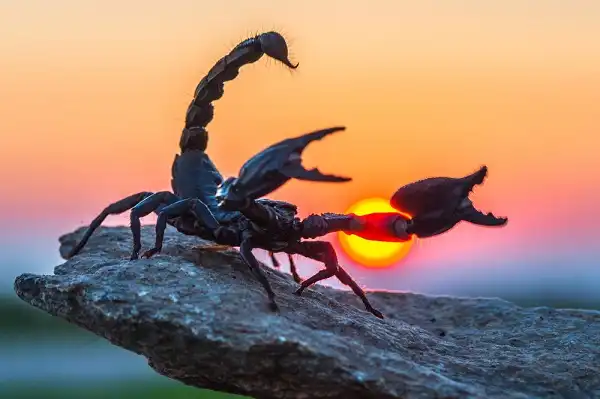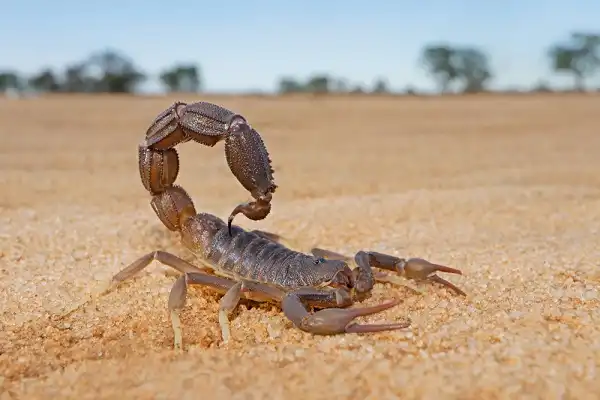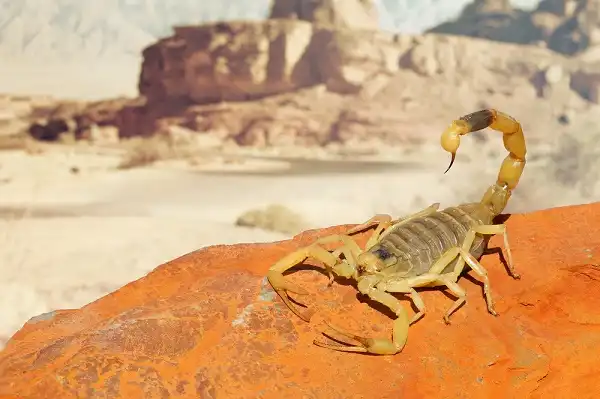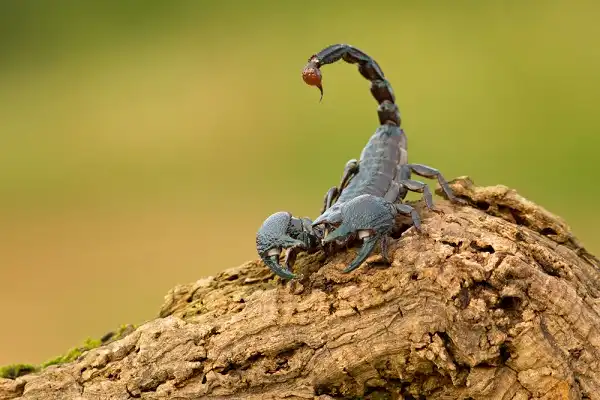Scorpions can be an intimidating sight to encounter, especially if you’re not familiar with them. They scuttle out of dark spaces and often have a reputation for being fierce desert predators. Although this is true in some cases, scorpions can also provide valuable benefits to our ecosystems! In this blog post, we’ll dive into the fascinating world of scorpions – exploring their behavior and biology and how humans interact with them. From deadly venomous species to timid dwarf varieties tucked away in remote areas, learning about these unique creatures is sure to blow your mind. So buckle up and come along for an adventure into the wild world of scorpions!

Scorpion Description
Scorpions are arachnid. They have a segmented body, eight legs, pincers, and a pair of antennae. They come in many different colors, including black, brown, yellow, and red. Most scorpions have two eyes located in the middle of their head between the two large pincers called pedipalps. These eyes usually can’t form pictures but sense light to help them find their prey. The body of a scorpion is covered with a hard exoskeleton made up primarily of chitin. This shell helps protect them from predators as well as provides insulation against heat and cold. On either side of their body, they have five small plates called “metasomal tergites” which give them a slightly flattened shape when viewed from the top or bottom. Scorpions also have four pairs of walking legs that are used for movement and one pair of pedipalps that are used for catching prey and defending themselves against predators.
Scorpion Habitat
Scorpions are found in a variety of habitats across the world, including deserts, forests, grasslands, and even suburban areas. They prefer warm climates but can also survive in cold temperatures. In the desert, scorpions can be found living among rocks and crevices to provide protection from the extreme heat during the day. In order to conserve water, they are nocturnal animals that hunt their prey at night. Scorpions will also burrow deep underground and create tunnels as shelter from predators and extreme temperatures. In forested areas and grasslands, scorpions may build webs or live under tree bark or logs for protection from predators. Suburban areas can be home to some species of scorpion if there is enough vegetation and wildlife present to sustain them. They usually find shelter under rocks or piles of leaves or wood while hunting for food at night.
Scorpion Diet
Scorpions are carnivores that primarily feed on insects, spiders, small lizards, and other small animals. They use their pedipalps to catch their prey and feed by using their chelicerae to crush the prey and suck out its fluids. Scorpions also have a pair of sensory organs at the base of their pedipalps which helps them detect vibrations from nearby prey so that they can ambush it. Scorpions usually feed on anything they can find including crickets, moths, cockroaches, spiders, centipedes, larvae, worms, grasshoppers, and even other scorpions. They sometimes scavenge for carrion as well. Larger species of scorpions may even hunt larger rodents or reptiles such as mice or snakes! In addition to hunting for food, scorpions may also eat plant material such as pollen or nectar from flowers. This helps provide them with additional nutrients needed to survive in the wild.
Scorpion Size
Scorpions vary widely in size, with some species only reaching a few centimeters long while others can grow up to 20 cm or more. The smallest species of scorpion are the Jack Jumper and the Australian Dwarf Scorpion, which are both less than 1 cm in length. The largest species is the Giant Forest Scorpion (Hadogenes troglodytes) which can reach lengths of up to 20 cm and weigh up to 60 grams!

Scorpion Lifespan
Scorpions have a wide range of lifespans depending on the species, with some living up to 25 years in captivity, and others only surviving around 1-2 years in the wild. In general, most scorpions live between 4-8 years in the wild and they reach maturity at about 2-3 years old. The lifespan of a scorpion is largely determined by its environment and diet. Scorpions living in harsher climates tend to have shorter lifespans as they are more vulnerable to extreme temperatures and environmental hazards such as drought or floods. On the other hand, those living in more hospitable environments can live longer due to increased food availability and more stable temperatures. Other factors that can influence a scorpion’s lifespan include disease, predation, and stress levels. A large amount of stress or disease can shorten a scorpion’s life significantly while predators such as birds, reptiles, or larger mammals may also reduce their lifespan if they are eaten before reaching full maturity.
Scorpion Behavior
Scorpion behavior is largely centered around their role as predators. Scorpions are nocturnal ambush predators, meaning they hide and wait for prey to pass by before swiftly pouncing on it and injecting venom. They will also often use their powerful claws to grab and hold onto prey while they sting and inject venom into it. Scorpions also have a highly developed sense of touch, thanks to the thousands of tiny hairs on their body that help them detect vibrations in the air or ground. This allows scorpions to sense when a potential prey item is nearby, so they can quickly attack before the prey has a chance to flee. In addition to being predators, scorpions also communicate with one another using chemical signals known as pheromones.
These are used during mating season when males compete for the female’s attention in order to mate. Males will also release these signals in order to ward off other males or attract females from a distance. When threatened by potential predators, scorpions may raise their pedipalps (claws) or curl up into a defensive ball so that their vital organs are protected from harm. Depending on the species, some may even display aggressive behavior such as hissing, arching their back or posturing with raised claws in order to ward off threats. Finally, scorpions typically live alone and rely heavily on camouflage for protection against both predators and potential mates. Some species may also dig burrows in which they can hide during the day while others find shelter under rocks or fallen logs when temperatures become too extreme outside.
Scorpion Speed
Scorpion speed varies depending on the species, but most species are capable of running at roughly 8-10 mph. This speed is usually used to catch up to prey and for fleeing from predators, although scorpions will also use their speed to search for food or explore new habitats. Some larger species of scorpion may be able to run up to 13 mph when threatened. Scorpions are known for their ability to traverse difficult terrain with ease due to their small size and long legs, which allow them to easily maneuver around rocks and crevices. Their ability to quickly scuttle sideways or backward makes them difficult prey for many predators as it helps them escape quickly if needed. In addition, scorpions have an impressive acceleration rate which helps them catch up with fast-moving prey while also allowing them to launch quick attacks when they sense potential danger nearby. They also have an impressive turning radius that allows them to quickly change direction and avoid obstacles in their path in a split second.

Scorpion Hunting
Scorpion hunting is a behavior that has been honed through millions of years of evolution. Scorpions use their speed and agility to quickly catch up to prey or flee from predators, using their powerful claws to grab hold of the prey and inject venom into them. Once they’ve captured their prey, they will typically consume it whole. Scorpions primarily hunt during the night when most potential predators are not active, relying on their highly developed sense of touch with the help of thousands of tiny hairs on their bodies to detect vibrations in the air or ground. This allows them to sense when a potential prey item is nearby, so they can swiftly attack before the prey has a chance to flee. In addition, scorpions also have an impressive acceleration rate which helps them catch up with fast-moving prey while also allowing them to launch quick attacks when they sense potential danger nearby. They also possess an impressive turning radius that allows them to quickly change direction and avoid obstacles in their path in a split second.
Scorpion Venomous Stingers
Scorpion venomous stingers are capable of delivering powerful neurotoxins that can paralyze or even kill their prey, making them highly effective hunters. Most scorpions have two venom-filled stinger-like organs located at the end of their tail. When an enemy approaches, they will often raise their tail to warn potential threats away, which also exposes the stingers. The venom is composed of a variety of neurotoxins and other compounds that function together to incapacitate or kill the scorpion’s prey. Depending on the species of scorpion, these compounds may include cytotoxins that destroy cells, hemotoxins that damage blood vessels, cardiotoxins that affect the heart, and neurotoxins that disrupt nerve impulses.
Scorpion venom can vary significantly depending on the species and environmental factors such as temperature and humidity. Some species may produce less potent toxins while others may generate more potent ones in order to better defend themselves against predators. In general, larger scorpion species tend to possess more powerful venoms than their smaller counterparts due to their greater size and larger venom glands. Furthermore, different scorpions may utilize different strategies for delivering their venom into their target’s body—some species inject it through a bite while others spray it from specialized glandular organs located near their tails. The amount of venom injected or sprayed can also vary between different species with some delivering a much higher dose than others in order to ensure a successful hunt.
Scorpion Predators
Scorpions have many predators, including spiders, centipedes, birds, lizards, and small mammals. These predators are able to catch the scorpion by either ambushing them or outrunning them in a chase. When a predator is successful in catching a scorpion, it will usually feed on it immediately. In addition to predators, other environmental factors can also threaten scorpions. Extreme temperatures can be fatal for some species of scorpions and even moderate temperatures can be dangerous if prolonged.
Additionally, too much humidity or too little water can also cause dehydration and ultimately lead to death. To protect themselves from potential predators and other environmental threats, scorpions employ several defensive strategies. For instance, they may hide under rocks or logs during the day when most predators are active and venture out only at night when they are less likely to encounter danger. They may also curl up into a defensive ball when threatened or raise their tail in warning as mentioned before. If necessary, they may also attack with their stinger-like organs to inject venom into their potential prey or predator.

Conclusion
Scorpions are fascinating creatures that have evolved a variety of powerful tools to help them hunt and defend themselves from predators. Their unique stinger-like organs contain potent neurotoxins that can incapacitate or even kill their prey and potential threats, making them highly efficient predators. They also possess several defensive tactics, such as hiding under rocks or raising their tail in warning, which enable them to survive in their environment despite the presence of many dangerous predators. Overall, scorpions provide us with an interesting example of how animals can evolve sophisticated strategies for successful hunting and self-preservation in the face of danger.
Frequently Asked Question


